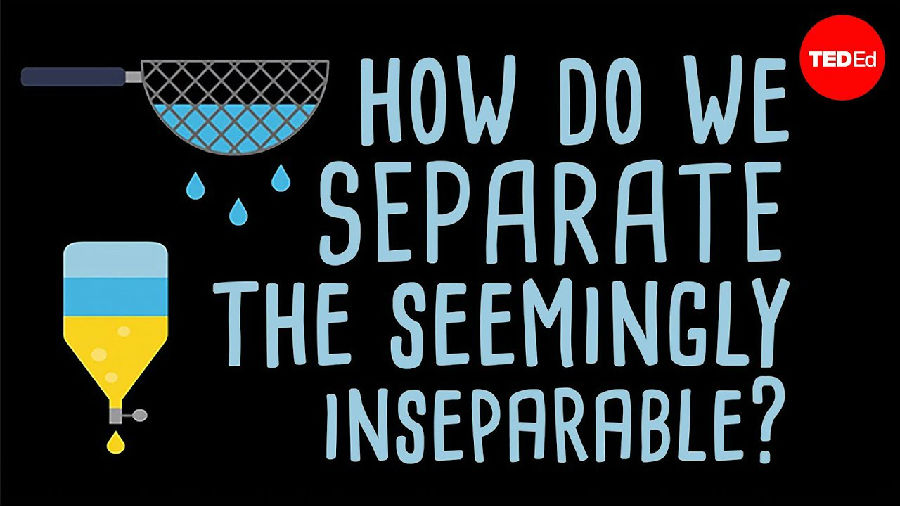(单词翻译:单击)
Your cell phone is mainly made of plastics and metals.
你的手机主要由塑料和金属制成。
It's easy to appreciate the inventive process by which those elements are made to add up to something so useful and entertaining.
我们很容易理解那些把各种元素加工成为有用又有趣的东西的发明过程。
But there's another story we don't hear about as much.
但是有件事我们没怎么听过。
How did we get our raw ingredients in the first place from the chaotic tangle of materials that is nature?
那就是,如何从自然中的混沌杂质第一时间得到我们想要的原材料呢?
The answer is a group of clever hacks known as separation techniques.
答案就在被称为分离技术的一组聪明的手段中。
They work by taking advantage of the fundamental properties of things to disentangle them from each other.
它们通过利用物质的基本属性,从而把物质相互分离。
Simple separation techniques apply to many physical scenarios,
在很多物理情况中会应用到简单的分离技术,
like separating cream from milk, extracting water from soil, or even sifting out flecks of gold from river sand.
例如从牛奶中分离出奶油,从泥土中提取水分,甚至从河砂中筛出黄金微粒。
But not all mixtures are so easy to unravel.
但并不是所有的混合物都是这么简单就被分离开的。
In some of those cases, we can exploit the differences between physical properties within a mixture,
在某些情况下,我们可以利用混合物物质性上的差异,
like particle size, density, or boiling point to extract what's required.
例如颗粒尺寸,密度或者沸点,去分离出我们想要的元素。
Take petroleum, a mixture of different types of hydrocarbons.
拿石油为例,它是由不同类的碳氢化合物混合而成。
Some of these are valuable as fuels, and others make good raw materials for generating electric power.
其中有的碳氢化合物可作为宝贵的燃料,其他的则可以作为产生电能的原材料。
To separate them, experts rely on one important feature: different hydrocarbons boil at different temperatures.
为了分离它们,专家们利用一个重要的特性:不同碳氢化合物的沸点也有所差别。
During the boiling process, each type vaporizes at a precise point,
在沸腾过程中,每一种成分都在一个比较精确的沸点蒸发,
then gets separately funneled into a container and collected as a liquid as it cools.
然后分别汇集在各自的容器中,冷却后以液体的形式储存。
Separation techniques also take us to the sea.
我们也将分离技术运用在海洋中。
In some drought-stricken countries, the ocean is the only available water source.
在一些遭受旱灾困扰的国家里,海洋是仅有的可用水源。
But of course, humans can't drink salt water.
当然了,人类是不能饮用盐水的。

One way to get around this problem is to remove salt from sea water with reverse osmosis,
解决这个问题的办法就是用反渗透方法将盐从海水中移除,
a process that separates water's ingredients by size.
这也是按大小分离水分子的过程。
A membrane with pores bigger than water particles, but smaller than salt particles,
一个比水质点大但却比盐分子小的有孔隙的薄膜,
only lets fresh water pass through, transforming what was once undrinkable into a life saver.
只允许淡水通过,将原来不能喝的水变为可饮用的生命之源。
Meanwhile in the medical world, blood tests are a vital tool for evaluating a person's health,
同时在医学领域,血液测试是评估个人健康的重要手段,
but doctors typically can't examine blood samples
但是医生一般不能检查血液样本,
until they've separated the solid blood cells from the liquid plasma they're dissolved in.
除非他将固态的血细胞从液体血浆中分离出来。
To do that, a powerful rotational force is exerted on the test tube,
为此,对试管施加强有劲的旋转力,
causing heavier substances with higher density, like blood cells, to move away from the rotational axis.
让高密度的比较重的物质,例如血细胞,远离旋转轴。
Meanwhile, lighter substances with lower density, like plasma, move to its center.
同时,低密度的较轻物质,例如血浆,就会留在中心。
The tube's contents divide clearly, and the blood cells and liquid plasma can be tested independently.
试管内的物质被分得一清二楚,这样血细胞和血浆就可以分别被检测了。
But sometimes, unlike oil, seawater, and blood,
但有些时候,不像石油、海水和血液,
the parts of mixtures that we want to separate share the same physical properties.
我们想要分离的混合物成分有着相同的物理属性。
In these cases, the only way to isolate ingredients is by chemical separation,
在这种情况中,分离原料的唯一方法就是化学分离,
a complex process that relies on unique interactions between components within a mixture and another material.
一个基于混合物成分和其他物质之间独特相互作用的复杂的过程。
One of these methods is chromatography, a tool forensic scientists use to examine crime scenes.
方法之一是色层分析法,这也是法医学家用来检测犯罪现场的一种手段。
They dissolve gathered evidence in a gas, and can monitor and analyze the ingredients
他们把收集到的证据溶解在一种气体中,就可以检测并分析其成分,
as they separate and move at varying speeds due to their unique chemical properties.
由于每一种成分都有其特殊的化学性质,所以它们会以不同的速度分离。
That information then tells scientists precisely what was present at the scene, often helping to identify the culprit.
科学家们能从这些信息中精确得知现场留下什么,利于识别出罪犯。
Separation techniques are not just about industry, infrastructure, medicine, and justice.
分离技术不光运用于工业、基础设施、医学和法律。
One of the most technically ambitious projects in human history
在人类历史中有一个“野心技术工程”,
is a separation technique aimed at answering the fundamental question, 'What is the Universe made of?'
旨在以一种分离手法回答一个最基本的问题:“宇宙是由什么组成的?”
By accelerating particles to extremely high speeds and smashing them into each other,
通过将粒子加速到极速,再让它们互相碰撞,
we can break them into their constituent parts ever so briefly.
我们能够在极短时间内将它们分成各自的组成部分。
And if we succeed at that, what's next?
如果我们成功了,那么接下来会是什么?
Is there a most elementary particle? And if so, what's it made of?
会有最基本的粒子存在吗?如果有,那它又是由什么构成的呢?


